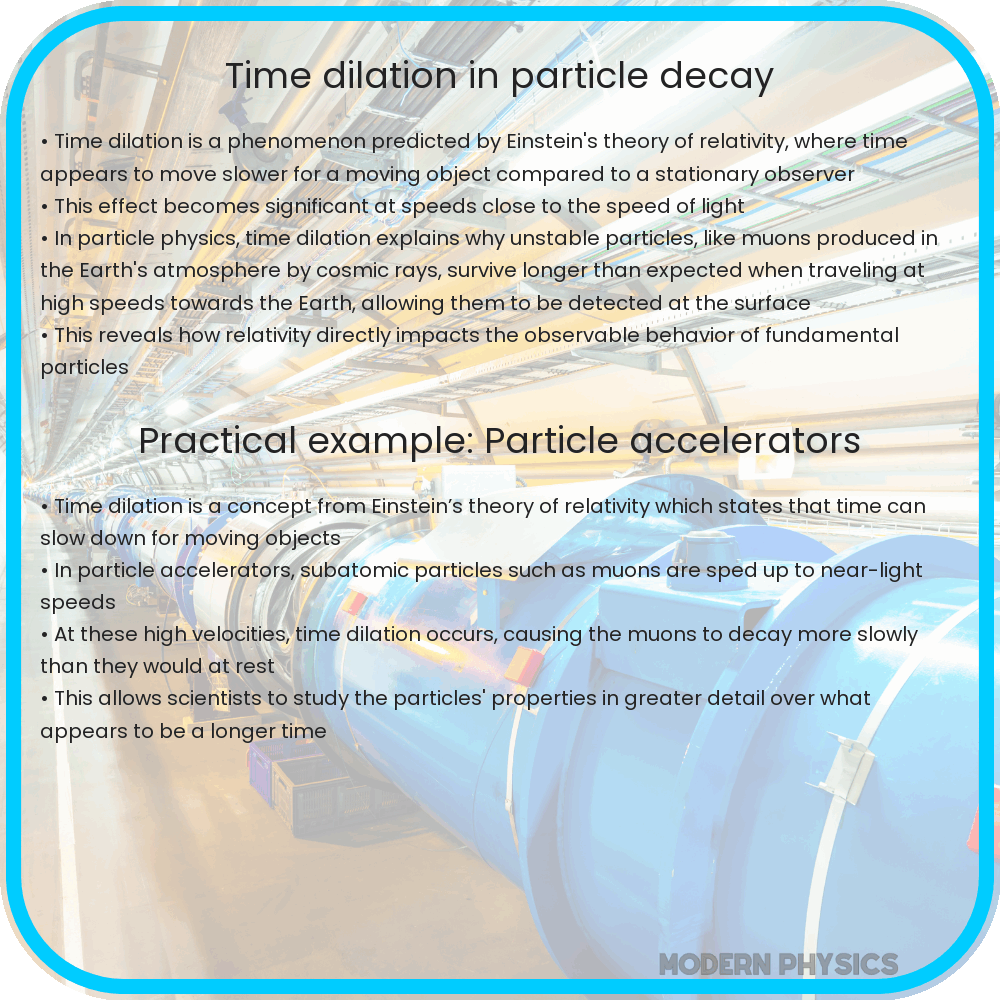Explore how time dilation affects particle decay in physics, examining relativity’s role in extending subatomic particles’ lifespans at high speeds.

Understanding Time Dilation in Particle Decay
Time dilation, a concept rooted in Albert Einstein’s Theory of Relativity, has profound implications in the realm of particle physics, particularly in understanding particle decay. This phenomenon illustrates how the lifespan and decay of subatomic particles are influenced by their speed and energy levels. In this article, we delve into the intricacies of time dilation and its impact on particle decay, offering insights into one of the most fascinating aspects of modern physics.
Time Dilation: A Relativistic Effect
At the heart of time dilation lies the principle that the rate at which time passes depends on an object’s velocity relative to the observer. According to Einstein’s Special Theory of Relativity, as an object approaches the speed of light, time appears to slow down for it from the perspective of a stationary observer. This effect is not noticeable at everyday speeds but becomes significant at velocities close to the speed of light.
Particle Decay in High-Speed Particles
Subatomic particles, such as muons and pions, are known to decay into other particles. Under normal circumstances, these particles have a fixed average lifespan, known as their half-life. However, when these particles travel at relativistic speeds (close to the speed of light), their half-life appears to extend, a direct consequence of time dilation.
For example, muons created in the Earth’s atmosphere by cosmic rays travel towards the Earth at high velocities. While their natural half-life would typically allow them to exist for only a brief moment, time dilation significantly prolongs their observed lifespan, enabling them to reach the Earth’s surface before decaying. This effect has been experimentally verified and serves as a compelling demonstration of time dilation in action.
Energy and Its Role in Particle Decay
The energy of a particle is intricately linked to its velocity and, consequently, to the time dilation it experiences. According to Einstein’s famous equation, E = mc2, the energy of a particle increases with its mass and the square of its velocity. As a particle’s energy increases, its speed approaches the speed of light, leading to more pronounced time dilation effects.
Therefore, in high-energy environments like particle accelerators, particles are accelerated to speeds close to that of light. This acceleration results in significant time dilation, thereby affecting the decay rates of these particles. Understanding and measuring these decay rates under various energy conditions have been crucial in testing and validating the principles of relativity and particle physics.
Experimental Evidence and Practical Applications
Time dilation in particle decay is not merely a theoretical concept but one that has been empirically validated. Particle accelerators, like the Large Hadron Collider (LHC), provide a platform for observing these phenomena. Here, particles are accelerated to near-light speeds, and their decay rates are measured. The data consistently align with the predictions of relativity, reinforcing the theory’s accuracy. Additionally, the decay of particles moving at relativistic speeds in cosmic rays provides natural evidence of time dilation.
Implications in Fundamental Physics and Beyond
The study of time dilation in particle decay has profound implications in fundamental physics. It not only validates the principles of relativity but also helps in understanding the fundamental properties of particles. For instance, it aids in determining the mass and energy levels of particles that are otherwise challenging to study due to their short-lived nature.
Beyond theoretical physics, these concepts find application in various technologies. For example, the Global Positioning System (GPS) satellites must account for time dilation effects to provide accurate positioning data. The satellites travel at high speeds and are in a different gravitational field compared to the Earth’s surface, necessitating adjustments based on both special and general relativity.
Conclusion
Time dilation in particle decay is a fascinating subject that bridges the gap between theoretical concepts and practical applications. It offers a compelling demonstration of Einstein’s relativity in the microscopic world of particle physics. By observing the extended lifespans of high-speed particles, scientists have gained invaluable insights into the nature of time and space. This understanding extends beyond the realm of fundamental physics, influencing technology and our daily lives. As our ability to study these phenomena becomes more refined, we continue to unravel the complexities of the universe, one particle at a time.
